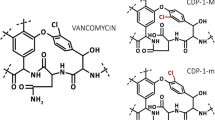Summary
Local antibiotic therapy by diffusion from plaster of Paris beads has proved promising in bone surgery. Sustained local delivery depends on thermostability, so we tested the antibacterial activity of 11 antibiotic solutions after storage at 37°C using a microbiological method. Cephalosporins and penicillins were unstable, but aminoglycosides remained fully stable with 100% activity after 2 weeks. About 60% of the initial bactericidal activity of quinolone, glycopeptides and sodium fusidate were still detectable after 2 weeks. Release of these antibiotics from plaster of Paris beads was evaluated in vitro. Even those in the same family differed in their release rate. Plaster beads with sodium fusidate were the most effective association. A therapeutic level of glycopeptides, aminoglycosides and amoxicillin was leached for about 3 weeks. Cephalosporins and sodium amoxicillin were released in 2 to 3 days, and quinolone beads were too brittle to be used. Plaster of Paris, which is cheap, biocompatible and biodegradable, is an excellent carrier for sodium fusidate, aminoglycosides and glycopeptides.
Résumé
L'antibiothérapie locale par diffusion d'antibiotique(s) à partir d'implants de plâtre de Paris constitue une approche prometteuse en chirurgie osseuse. Etant donné que l'administration locale et prolongée d'un antibiotique dépend de sa thermostabilité, l'activité antibactérienne de onze solutions d'antibiotiques a été mesurée par une méthode microbiologique après stockage à 37°C. Les céphalosporines et les pénicillines sont instables dans ces conditions (moins de 10% de leur activité initiale est maintenue après deux semaines). A l'opposé, les aminoglycosides sont tout-à-fait stables (100% de leur activité est mesurée après deux semaines). Environ 60% de l'activité antibactérienne initiale des quinolones, des glycopeptides et du fusidate sodique est encore détectable après deux semaines. La libération de ces antibiotiques à partir des billes de plâtre de Paris a été évaluée in vitro. Le fusidate sodique associé à ce vecteur présente une libération constante et soutenue du principe actif. Cette propriété le rend particulièrement adapté pour le traitement d'infections osseuses. Des concentrations thérapeutiques en glycopeptides, en aminoglycosides et en amoxicilline trihydrate sont obtenues pendant une à deux semaines. Par contre, les céphalosporines et l'amoxicilline sodique sont trop rapidement libérés (2 à 3 jours) et finalement les billes chargées de quinolones sont trop friables pour être utilisables. Grâce à son coût, sa facilité d'utilisation et de stérilisation ainsi que sa biocompatibilité, le plâtre de Paris constitue un excellent vecteur d'antibiotiques tels que le fusidate sodique, les aminoglycosides et les glycopeptides.
Similar content being viewed by others
References
Bouillet R, Bouillet B, Kadima N, Gillard J (1989) Traitement de l'ostéomyélite chronique en milieu africain par implants de plâtre imprégné d'antibiotiques. Act Orthop Belg 55: 1–11
Dahners LE, Funderburk CH (1987) Gentamicin loaded plaster of Paris as a treatment of experimental osteomyelitis in rabbits. Clin Orthop 219: 278
Dressman H (1892) Veber Knochenplombierung. Beitr Klin Chir 9: 804–810
Edberg E (1930) Some experiences of filling osseous cavities with plaster. Acta Chir Scand 67: 313
Evrard J, Kerri O, Martini M, Conort O (1990) Traitement des infections osseuses par linguettes de plâtre de Paris imprégnées d'antibiotiques. Pathol Biol 38: 543–547
Grove DC, Randall AW (1955) Assay methods of antibiotics. Medical Encyclopedia Inc, New-York
Josefsson G, Lindberg L, Wiklander B (1981) Systemic antibiotics and gentamicin-containing bone cement in the prophylaxis of postoperative infections in total hip arthroplasty. Clin Orthop 159: 194–200
Kovacevic B (1953) Ein Beitrag zum Problem der hämatogen Osteomyelitis. Dtsch Ztschr Chir 276: 432–443
Lortat-Jacob A (1992) Les antibiotiques — principes de prescription. In: Infection osseuse post-traumatique. Masson, Paris, pp 103–105
Mackey D, Varlet A, Debeaumont D (1982) Antibiotic loaded plaster of Paris pellets: an in vitro study of a possible method of local antibiotic therapy in bone infection. Clin Orthop 167: 263–268
Mackey D, Varlet A (1984) Antibiotic-impregnated gypsum pellets in the surgical management of chronic osteomyelitis. Inter Med 9: supp.
Mousset B, Benoit M-A, Bouillet R, Gillard J (1993) Le plâtre de Paris: un vecteur d'antibiotiques pour le traitement des infections osseuses. Acta Orthop Belg 59: 239–248
Mousset B, Benoit M-A, Vandamme T, Bouillet R, Delloye C, Gillard J (1992) Antibiotic sustained release in infected bones. Sixth International Conference on Pharmaceutical Technology, Paris, France
Nielson A (1944) Filling of sterile and infected cavities by means of plaster of Paris. Acta Chir Scand 91: 17
Peltier LF (1961) The use of plaster of Paris to fill defects in bones. Clin Orthop 21: 1–31
Perry CR, Pearson RL (1991) Local antibiotic delivery in the treatment of bone and joint infections. Clin Orthop 263: 215–226
Petrova A (1928) Gipsfüllung von Knochenhöhlen bei Osteomyelitis. Zentral Ges Chir 43: 885
Scott DM, Rotschafer JC, Behrens F (1988) Use of vancomycin and tobramycin polymethylmethacrylate impregnated beads in the management of chronic osteomyelitis. Drug Intell Clin Pharm 22: 480–483
Varlet A, Dauchy Ph (1983) Billes de plâtre de Paris aux antibiotiques dans le traitement de l'infection osseuse. Nouvelles associations plâtre-antibiotiques. Rev Chir Orthop 69: 239–244
Varlet A, Dauchy Ph, Hingrez M (1985) Ostéogenèse induite par l'addition de matrice osseuse déminéralisée à des billes de plâtre aux antibiotiques. Etude chez l'animal. Rev Chir Orthop 71: 73–78
Vecsei V, Starlinger M (1982) Gentamycin-PMMA bead chains in the treatment of posttraumatic osseous and tissue infections. Arch Orthop Traumat Surg 99: 259–263
Wahlig H (1991) Septopal — A review of its properties and pharmacokinetics. In: Antibiotic carriers. A new approach to the local treatment of infection in surgery. Medizinischpharmazeutische Verlagsges mbH, pp 9–18
Wahlig H, Dingeldeim E (1980) Antibiotics and bone cements. Experimental and clinical long-term observations. Acta Orthop Scand 51: 49–56
Wei G, Kotoura Y, Oka M, Yamamuro T, Wada R, Hyon S, Ikada YA (1991) Bioresorbable delivery system for antibiotic treatment of osteomyelitis. The use of lactic acid oligomer as a carrier. J Bone Joint Surg [Br] 73: 246–252
Author information
Authors and Affiliations
Rights and permissions
About this article
Cite this article
Mousset, B., Benoit, M.A., Delloye, C. et al. Biodegradable implants for potential use in bone infection. International Orthopaedics 19, 157–161 (1995). https://doi.org/10.1007/BF00181861
Accepted:
Issue Date:
DOI: https://doi.org/10.1007/BF00181861




